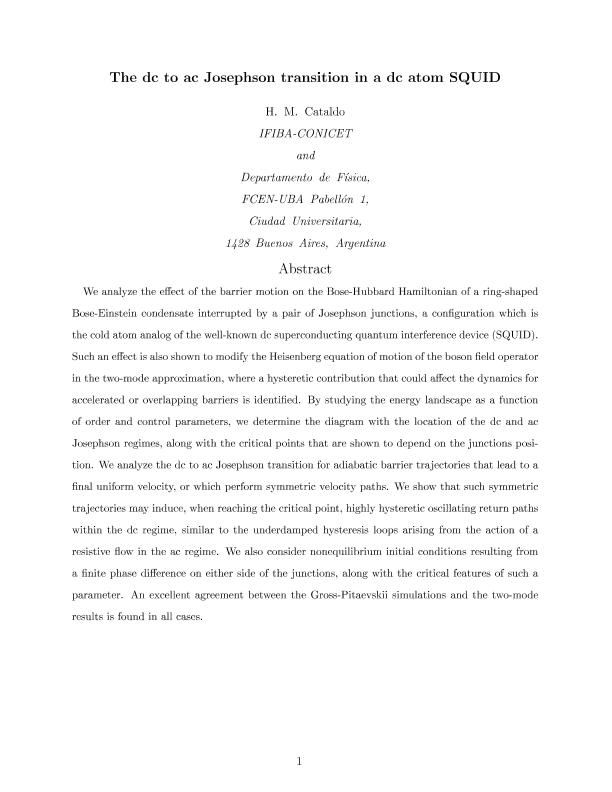Mostrar el registro sencillo del ítem
dc.contributor.author
Cataldo, Horacio Maximo

dc.date.available
2021-11-11T18:26:43Z
dc.date.issued
2020-08
dc.identifier.citation
Cataldo, Horacio Maximo; Dc to ac Josephson transition in a dc atom superconducting quantum interference device; American Physical Society; Physical Review A: Atomic, Molecular and Optical Physics; 102; 2; 8-2020; 1-35
dc.identifier.issn
2469-9926
dc.identifier.uri
http://hdl.handle.net/11336/146733
dc.description.abstract
We analyze the effect of the barrier motion on the Bose-Hubbard Hamiltonian of a ring-shaped Bose-Einstein condensate interrupted by a pair of Josephson junctions, a configuration which is the cold-atom analog of the well-known dc superconducting quantum interference device (SQUID). Such an effect is also shown to modify the Heisenberg equation of motion of the boson field operator in the two-mode approximation, where a hysteretic contribution that could affect the dynamics for accelerated or overlapping barriers is identified. By studying the energy landscape as a function of order and control parameters, we determine the diagram with the location of the dc and ac Josephson regimes, along with the critical points that are shown to depend on the junction's position. We analyze the dc to ac Josephson transition for adiabatic barrier trajectories that lead to a final uniform velocity, or which perform symmetric velocity paths. We show that such symmetric trajectories may induce, when reaching the critical point, highly hysteretic oscillating return paths within the dc regime, similar to the underdamped hysteresis loops arising from the action of a resistive flow in the ac regime. We also consider nonequilibrium initial conditions resulting from a finite phase difference on either side of the junctions, along with the critical features of such a parameter. An excellent agreement between the Gross-Pitaevskii simulations and the two-mode results is found in all cases.
dc.format
application/pdf
dc.language.iso
eng
dc.publisher
American Physical Society

dc.rights
info:eu-repo/semantics/openAccess
dc.rights.uri
https://creativecommons.org/licenses/by-nc-sa/2.5/ar/
dc.subject
ULTRACOLD GASES
dc.subject
JOSEPHSON JUNCTIONS
dc.subject
ATOM SQUID
dc.subject
HYSTERESIS
dc.subject.classification
Física Atómica, Molecular y Química

dc.subject.classification
Ciencias Físicas

dc.subject.classification
CIENCIAS NATURALES Y EXACTAS

dc.title
Dc to ac Josephson transition in a dc atom superconducting quantum interference device
dc.type
info:eu-repo/semantics/article
dc.type
info:ar-repo/semantics/artículo
dc.type
info:eu-repo/semantics/publishedVersion
dc.date.updated
2021-09-07T18:26:44Z
dc.identifier.eissn
2469-9934
dc.journal.volume
102
dc.journal.number
2
dc.journal.pagination
1-35
dc.journal.pais
Estados Unidos

dc.journal.ciudad
New York
dc.description.fil
Fil: Cataldo, Horacio Maximo. Consejo Nacional de Investigaciones Científicas y Técnicas. Oficina de Coordinación Administrativa Ciudad Universitaria. Instituto de Física de Buenos Aires. Universidad de Buenos Aires. Facultad de Ciencias Exactas y Naturales. Instituto de Física de Buenos Aires; Argentina
dc.journal.title
Physical Review A: Atomic, Molecular and Optical Physics

dc.relation.alternativeid
info:eu-repo/semantics/altIdentifier/url/https://link.aps.org/doi/10.1103/PhysRevA.102.023323
dc.relation.alternativeid
info:eu-repo/semantics/altIdentifier/doi/http://dx.doi.org/10.1103/PhysRevA.102.023323
Archivos asociados
